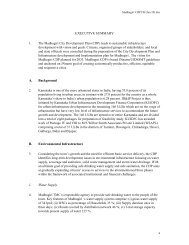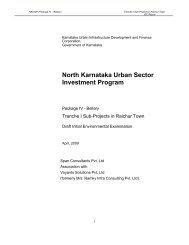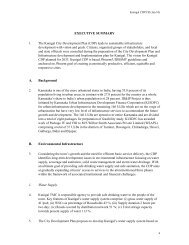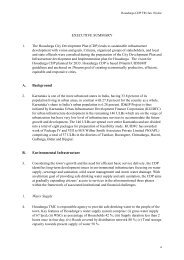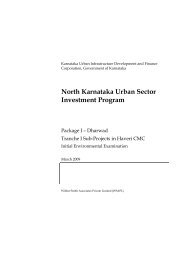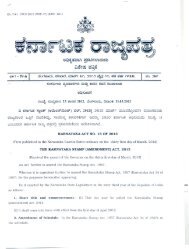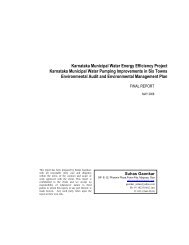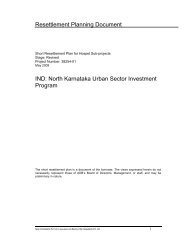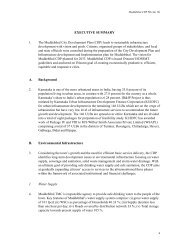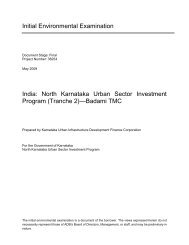Davangere 38254-053-ind-iee-02.pdf - kuidfc
Davangere 38254-053-ind-iee-02.pdf - kuidfc
Davangere 38254-053-ind-iee-02.pdf - kuidfc
You also want an ePaper? Increase the reach of your titles
YUMPU automatically turns print PDFs into web optimized ePapers that Google loves.
22demonstrate its fertilizer value and to develop a market value for the digested and dried sludge.83. Records of desludging will show the time and quantity of sludge drawn to each bed, thedepth of loading, the depth of sludge after drying time, and the quantity of dried sludgeremoved. The solids content of wet digested sludge, its volatile portion and pH will bedetermined and recorded. Likewise the moisture content and fertilizer value in terms of NPK andpresence of pathogens in dried sludge will also be analysed and recorded.84. Sludge handling workers’ safety must be considered and safe sludge handling methodsshall be employed. Personal protection equipment such as gloves; boots, etc. shall be provided.Sludge handling workers must be provided with regular free medical checkup facilities.E. Cumulative Impact Assessment85. The cumulative impact assessment (CIA) examined the interaction between thesubproject’s residual effects (i.e., those effects that remain after mitigation measures have beenapplied) and those associated with other past, existing, and reasonably foreseeable futureprojects or activities. The interaction of residual effects associated with multiple projects andactivities can result in cumulative impacts, both positive and negative. The subproject’s potentialcumulative effects were considered with respect to valued components (VCs) in environmental,socioeconomic, and heritage resources categories, in four areas:(i).(ii).(iii).(iv).of any potential residual project effects that may occur incrementally over time;in consideration of other known relevant projects or activities within the specifiedstudy area boundaries, even if not directly related to the subproject;of any potential overlapping impacts that may occur due to other developments,even if not directly related to the proposed project; andin future developments that is reasonably foreseeable and sufficiently certain toproceed.86. The subproject IEE has identified the VCs as air quality, water (surface andgroundwater) quality, noise, geophysical (hydrogeological), traffic management, socioeconomicand sociocommunity, cultural resources, and human health. There are no foreseeable projectsthat will overlap with the subproject. The spatial boundary of the subproject is the area along thealignment and the existing RoWs. The temporal boundary can be considered as the whole<strong>Davangere</strong> City.87. Air quality effects will be seen during construction. Consequently, although emissions ofcommon air contaminants (CAC) and fugitive dust may be elevated in proximity to active worksites, this impact will be short-term and localized to the immediate vicinity of the alignment.Greenhouse gas (GHG) emissions may increase as a result of project activities (i.e., vehicle andequipment operation, concrete production, disposal of excavated material, disposing of residualwastes). Given the subproject’s relatively minor contribution to CAC and GHG emissions duringconstruction, the overall significance rating of both these potential residual effects is considerednegligible.88. During construction noise levels in the immediate proximity of most work sites areexpected to increase. The duration of this exposure will be relatively brief. This exposurerepresents a temporary, localized, adverse residual effect of low to moderate significance foraffected receptors. While building damage due to ground vibrations is unlikely given themitigation measures in place, there may be annoyance to spatially located receptors duringconstruction. Noise levels associated with the project operations will be largely imperceptible, as



